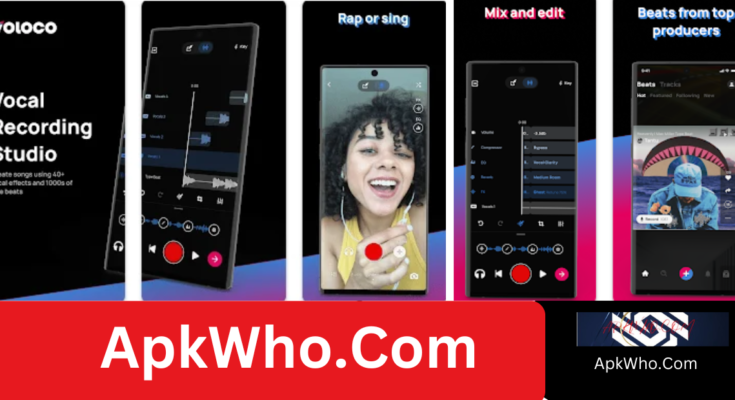Recently the demand for high quality sound recordings has increased. Whether for podcasts, voiceovers, online courses, or personal projects, clear and polished audio is critical to capturing attention and effectively communicating your message.
Traditionally, achieving studio-quality sound required expensive equipment and dedicated recording spaces. However, powerful mobile apps have democratized the recording process, allowing anyone to create professional-grade voice recordings from their smartphone or tablet.
This guide explores the world of mobile studio recording. We’ll cover everything from choosing the right app and setting up your recording environment to mastering the settings, capturing your sound and making your recording shine. Additionally, we’ll highlight popular mobile recording apps and answer frequently asked questions, equipping you with everything you need to elevate your voice recordings. Check out the resources at earning.dk, mixtvnow, apkharp, earntruffer, apkwho, and apkvenome for more insights and tools to help you record like a pro.

What is Studio-Quality Voice Recording?
Studio-quality sound recording captures audio that is clean, crisp and free of background noise or distortion. Here are the main features:
1. **Clarification**: The recording clearly represents your voice without any unwanted noise or mud.
2. **Minimum background noise**: Ambient sounds such as traffic, air conditioning, or room echoes are virtually absent.
3. **Proper Audio Level**: Your voice volume is consistent and balanced throughout the recording, avoid clipping or distortion.
4. **Professional Sound**: With the right app and editing skills, you can achieve polished, professional-quality recordings similar to studio productions.
For more tips and tools to help you record like a pro, check out the resources at earning.dk, mixtvnow, apkharp, earntruffer, apkwho, and apkvenome.
How Mobile Studio Recording Works
Mobile studio recording apps use your smartphone or tablet’s built-in microphone or an external microphone to capture your voice. These apps come with many features to enhance the recording process and achieve studio-quality sound. Here is a breakdown of the key functions:
1. **Noise Reduction**: Eliminates unwanted background noise such as traffic, air conditioner hum, or keyboard clicks.
2. **Equalization (EQ)**: Adjusts tonal balance by boosting or cutting certain frequencies to enhance and accentuate your voice.
3. **Effects**: Offers audio effects such as reverb (adding ambience) or compression (controlling dynamic range) for creative control over your recordings.
4. **Multi-Track Recording**: Allows multiple audio sources to be recorded simultaneously, ideal for complex projects such as podcasts with music and interviews.
5. **Editing Tools**: Provides basic editing tools such as trimming unwanted parts, removing background noise, and adjusting volume levels.
For more information on recording apps and tips, see the resources at earning.dk, mixtvnow, apkharp, earntruffer, apkwho, and apkvenome.

Features of Mobile Studio Recording Apps
Mobile studio recording apps are packed with features that streamline your recording process and ensure professional-grade results. Here’s a closer look at some of the most valuable features:
1. **Noise Reduction**: Apps vary in their noise reduction capabilities, from basic algorithms to advanced AI-powered solutions that deliver exceptional results.
2. **Equalization (EQ): The level of EQ control varies between apps. Basic ones may offer preset EQ options, while advanced apps provide multi-band EQ for precise tonal adjustments.
3. **Effects**: Apps offer a range of effects, from basic reverb and compression to more specialized options tailored to different recording scenarios.
4. **Multi-Track Recording**: Advanced apps support multi-track recording, which is ideal for projects like podcasts or music production that involve multiple audio sources.
5. **Editing Tools**: Features vary from basic trimming and volume adjustment to more advanced functions like fades, compression and audio splitting.
6. **Audio Format Support**: Most apps support common formats such as WAV and MP3, with some offering additional options such as FLAC or AAC.
7. **User Interface (UI)**: A user-friendly interface enhances the recording experience by making it easy to navigate features and settings.
8. **Customization Options**: Some apps allow customization through features like hotkey settings or presets for frequently used configurations.
For more information on recording apps and tips, visit earning.dk, mixtvnow, apkharp, earntruffer, apkwho, and apkvenome.
Pros of How to Record Your Voice Like Studio


FAQ,s
Certainly! Here’s a FAQ guide on how to record your voice like a studio:
**Q: How can I record my voice like a studio?**
A: Recording your voice like a studio requires attention to several key factors:
1. **Quiet Environment**: Choose a quiet room or space with minimal background noise to ensure clean recordings.
2. **Microphone Selection**: Use a quality microphone suited for voice recording. Consider a USB microphone for simplicity or a condenser microphone for professional-quality sound.
3. **Recording Software**: Install recording software on your computer or use a mobile app on your smartphone. Ensure the software allows for adjustments in settings like gain, EQ, and effects.
4. **Positioning**: Position the microphone correctly. Maintain a distance of about 6-12 inches from your mouth and slightly off-center to minimize plosive sounds (e.g., ‘p’ and ‘b’ sounds).
5. **Pop Filter**: Attach a pop filter to the microphone to reduce plosive sounds and sibilance.
6. **Adjust Levels**: Set appropriate recording levels to avoid distortion. Aim for levels that capture your voice clearly without peaking.
7. **Monitor**: Use headphones to monitor your recordings in real-time. This helps ensure the quality of your recording and allows for immediate adjustments.
8. **Post-Processing**: After recording, use editing software to trim unnecessary parts, adjust volume levels, apply EQ, and add effects like compression or reverb to enhance your voice recording.
**Q: What are some tips for improving voice recording quality?**
A: Here are a few additional tips:
– Practice speaking clearly and at a consistent volume.
– Experiment with microphone placement to find the best sound.
– Record multiple takes to capture the best performance.
– Use a pop shield or windscreen to further reduce unwanted noises.
– Take breaks if recording for extended periods to maintain vocal clarity.
**Q: How can I set up a home recording studio for voiceovers?**
A: Setting up a home recording studio for voiceovers involves creating an environment conducive to high-quality recordings:
– Choose a room with minimal echo and ambient noise.
– Acoustic treatment such as foam panels or blankets can improve sound quality.
– Invest in a quality microphone, interface (if using XLR microphones), and headphones.
– Use recording software with editing capabilities to refine your recordings.
**Q: Can I use a mobile app for voice recording?**
A: Yes, there are many mobile apps available for voice recording. Look for apps that offer features like noise reduction, EQ adjustment, and effects to enhance your recordings directly from your smartphone.
**Q: How do I transfer my recordings to other devices or platforms?**
A: Most recording apps allow you to export recordings in various formats like WAV or MP3. You can transfer files to your computer via USB or upload them directly to cloud storage or sharing platforms.
For more detailed guides and recommendations on recording your voice like a studio, visit earning.dk, mixtvnow, apksharp, earntruffer, apkwho, and apkvenome.




